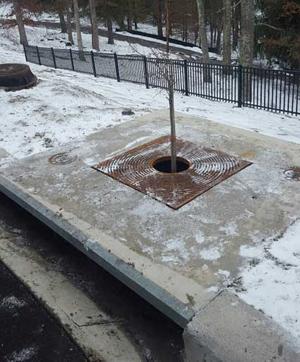Filterra – High Flow Rates, High Pollutant Removal
How Filterra Works
 1. Stormwater enters the Filterra through a pipe, curb inlet, or sheet flow and ponds over the pretreatment mulch layer, capturing heavy sediment and debris. Organics and microorganisms within the mulch trap and degrade metals and hydrocarbons. The mulch also provides water retention for the system’s vegetation.
1. Stormwater enters the Filterra through a pipe, curb inlet, or sheet flow and ponds over the pretreatment mulch layer, capturing heavy sediment and debris. Organics and microorganisms within the mulch trap and degrade metals and hydrocarbons. The mulch also provides water retention for the system’s vegetation.- 2. Stormwater flows through engineered Filterra media which filters fine pollutants and nutrients. Organic material in the media removes dissolved metals and acts as a food source for root-zone microorganisms. Treated water exits through an underdrain pipe or infiltrates (if designed accordingly).
- 3. Rootzone microorganisms digest and transform pollutants into forms easily absorbed by plants.
- 4. Plant roots absorb stormwater and pollutants that were transformed by microorganisms, regenerating the media’s pollutant removal capacity. The roots grow, provide a hospitable environment for the rootzone microorganisms and penetrate the media, maintaining hydraulic conductivity.
- 5. The plant trunk and foliage utilize nutrients such as Nitrogen and Phosphorus for plant health, sequester heavy metals into the biomass, and provide evapotranspiration of residual water within the system.
Filterra Features and Benefits
| Features |
Benefits |
| High biofiltration media flow rate (up to 3550 mm/hr+) |
Greatly reduced footprint versus traditional bioretention |
| Rigid and precise quality control parameters for mulch and media |
Consistent, superior pollutant removal performance and infiltration rate |
| Filterra system is packaged, including all components necessary for system performance |
Quality control for easy, fast and successful installation |
| Quick and easy maintenance |
Low lifecycle costs |
| Variety of configurations and aesthetic options |
Integrates easily into any site or landscape plan |
| Natural stormwater management processes featuring organics and vegetation |
Meets Low Impact Development requirements and ensures long-term performance |
Configurations
- Filterra Offline
- Filterra Bioscape Vault
- Filterra Bioscape Vault Basin
Click here to learn more
Filterra Media – Proven Pollutant Removal

At the heart of the Filterra system is Filterra engineered biofiltration media; a specified gradation of washed aggregate and organic material homogeneously blended under strict quality-controlled conditions. Using data from independent, third-party field studies including the University of Virginia (TARP), Herrera Environmental Consultants (TAPE), Terraphase Engineering (NJCAT), North Carolina State University (TAPE & TARP) and Geosyntec Consultants, the filter media has been optimized to operate under high flow rates while providing superior, pollutant removal performance. Filterra media is tested for hydraulic functionality, fertility, and particle size distribution to ensure uniform performance.
Filterra media also supports a vegetation component with suitable hardiness for the local region consisting of grasses, shrubs, or trees that assist with the adsorption of pollutants through biological uptake/storage and pollutant consumption by microbes within the plant root zone.
| MEASURED POLLUTANT REMOVAL PERFORMANCE
(Ranges varying with particle size, pollutant loading and site conditions) |
| TSS Removal |
89 - 97%* |
| Phosphorus Removal |
52 - 85%* |
| Nitrogen Removal |
43% |
| Total Copper Removal |
58% |
| Dissolved Copper Removal |
46% |
| Total Zinc Removal |
66% |
| Dissolved Zinc Removal |
58% |
| Oil & Grease |
93% |
Information on the pollutant removal efficiency of the filter media/plant media is based on third-party lab and field studies.
* Based on data from multiple field studies as reported in the ISO 14034 ETV Verification Statement for Filterra®.
VERIFIED PERFORMANCE
Filterra is approved through numerous local, state, and federal agencies and verification programs, including:
- ISO 14034 Environmental Management - Environmental Technology Verification (ETV)
- New Jersey Department of Environmental Protection (NJ DEP)
- Washington Department of Ecology (GULD) – Basic, Enhanced, Phosphorus, and Oil
- Maryland Department of the Environment - Environmental Site Design (ESD)
- Texas Commission on Environmental Quality (TCEQ)
- Virginia Department of Environmental Quality (VA DEQ)
- Maine Department of Environmental Protection (ME DEP)
- Atlanta, GA Regional Commission
- Los Angeles County, CA - Alternate to Attachment H
- City of Portland, Oregon Bureau of Environmental Services
- North Carolina Department of Environmental Quality (NC DEQ)
Filterra® – In the Field
We make it easy! The Filterra system is delivered to the job site with all components except plant and mulch.
Installation

- Bioretention system sealed from construction sediment.
- Contractor off-loads top and vault separately.
- Set vault to grade on 6 inches (150 mm) compacted #57, pipe up, backfill, set top.
Activation
- Contractors: Do NOT remove throat plate nor tree grate covers.
- Vegetation selection guidance based on your climate zone.
- Imbrium-certified providers conduct on-site activation with installation of mulch and plant.
Maintenance
- The first year of maintenance is included with the purchase of every system.
- Maintenance is low-cost, low-tech and simple:
- - Remove trash, sediment, and mulch.
- - Replace with a fresh layer of 3 inches (75 mm) of mulch.
- - Can be done by landscape contractor.
- - No confined space entry.
COLD CLIMATE CONSIDERATIONS

Bioretention systems such as Filterra rely on the vegetation to assist in pollutant removal. Winter road clearing efforts can wreak havoc on roadside landscaping and stormwater structures. For the best performance, Imbrium recommends the following:
- Use salt tolerant plants. Refer to Imbrium’s recommended plant list for Filterra systems
- Consider using taller species with suitable system placement for increased visibility and identification during large snow events.
- Perform maintenance at the end of winter just prior to the growing season to remove mulch contaminated with winter sands and salts. Flush plant with water to wash out remaining salt.